AMD vs. Intel Performance
At this point it's not too big of a surprise that AMD is the stronger performer when it comes to gaming performance. It's actually at the point where even insiders at Intel will admit and recognize that Intel is no longer the king of gaming performance as they once were long ago. But how bad is it under Half Life 2? Let's take a look at our five custom demos to find out.
We used the current king of Half Life 2 performance for all of our CPU tests - the ATI Radeon X850 XT Platinum Edition running at 1280 x 1024, to give a good balance between CPU and GPU limitations while providing realistic performance figures. Note that all of the Intel CPUs tested here are LGA-775 and all of the AMD CPUs are Socket-939.
First we have at_canals_08, generally a good GPU test, meaning that its CPU dependency is minimized. The benchmark includes a decent number of NPCs and firefights but is severely offset by things like water and flashlight usage, both of which are more GPU intensive elements of the benchmark.
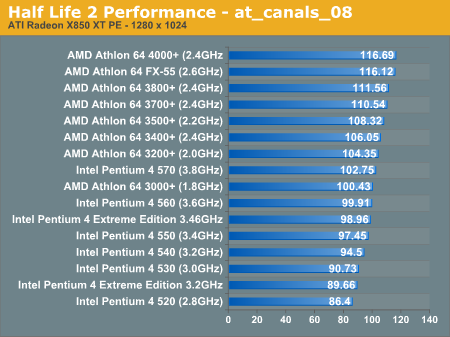
Things don't look so good for Intel here, the Pentium 4 570J is the only Intel CPU capable of outperforming the Athlon 64 3000+. Unfortunately for Intel, AMD's Athlon 64 4000+ is about 14% faster at 1280 x 1024.
The Extreme Edition CPUs don't do much for Intel, as Prescott does appear to perform equal or better clock for clock than the older Northwood core.
Next let's take a look at at_coast_05, another very GPU limited test that has a good deal of NPC interaction as well as GPU limiting elements:
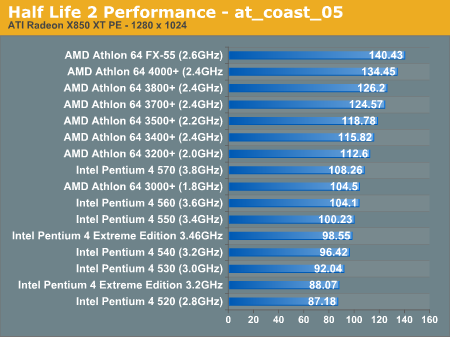
The results here are very similar to what we saw under at_canals_08, with the Pentium 4 570J offering performance slightly higher than the Athlon 64 3000+ but that's about it for Intel. The Athlon 64 4000+ is an impressive 24% faster than Intel here which honestly is nothing to scoff at.
Our next demo, at_coast_12, doesn't change much either:
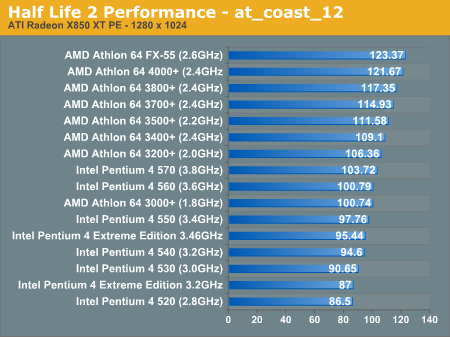
The performance under at_prison_05 is a little closer:
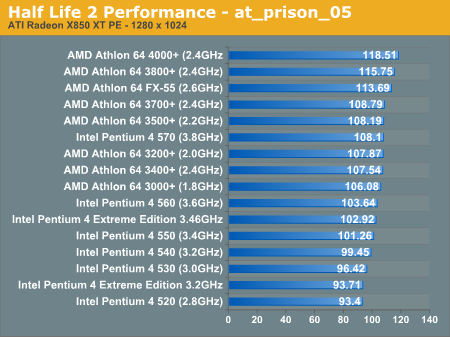
Finally we have an excellent CPU benchmark, at_c17_12. The test is extremely CPU bound, and thus makes the perfect conclusion to this section:
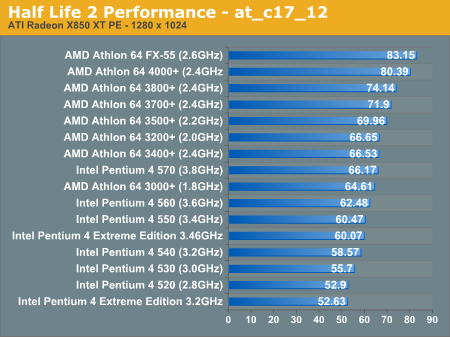
While you can argue that AMD's performance advantages in the other tests aren't noticeable on a price-for-price basis, you can't argue with the results here. At the $280 - $290 price point, AMD's Athlon 64 3500+ delivers about 15% more performance than Intel's Pentium 4 550.
The margin is even greater at the low end, AMD's Athlon 64 3000+ is 23% faster than Intel's similarly priced Pentium 4 520.
At the high end the advantage is equally in AMD's favor, with the Athlon 64 4000+ holding a 22% advantage over Intel's fastest Pentium 4.
Conclusion? Don't look any further than AMD for the best gaming CPU, and Half Life 2 further cements AMD's reputation as the gamer's CPU.










68 Comments
View All Comments
Phantronius - Wednesday, January 26, 2005 - link
#3NF4 will not be supporting AGP bud, sorry, its PCI-E from here on out.
Ozz1113 - Wednesday, January 26, 2005 - link
Ill backup the thought of putting some T-bred cores in there. My OC'd XP2600 333 w\ modded 9500 radeon system ran HL2 very well. I would have liked it to have been better, but it is not worth upgrading yet.Araemo - Wednesday, January 26, 2005 - link
Hehehe.. I'll fifteenth the "Please include an AXP3200+" sentiment. Personally, I'd rather see one or two AXPs included than a complete list of athlon64s.. You can generally extrapolate the performance of a given CPU if you are given two other CPUs with the same cache/FSB/core. I know that my Mobile barton handled the game fine, but I'd like to know how far behind a cheap A64 it really is.miketheidiot - Wednesday, January 26, 2005 - link
"Our standard 2-2-2-10 memory does actually offer reasonable performance benefits in Half Life 2 compared to DDR400 with higher timings such as 3-3-3-10 or the unrealistically high 3-6-6-10."Reasonable performance benefits? decent 2.5-3-3-10 ram can be found cheap nowdays (http://www.newegg.com/app/ViewProductDesc.asp?desc... and compared to the oczrev2 and other $200+ modules is at least $60 cheaper, in some case as much as $100 cheaper. The 2-2-2 is only 2% faster than the 3-3-3, so does that extra $60+ really offer "reasonable performance benefits"?
Jeff7181 - Wednesday, January 26, 2005 - link
#13... I wouldn't call that an error, I'd call that a difference in opinion. :)PrinceGaz - Wednesday, January 26, 2005 - link
There seems to be an error on page 4- "Almost all DDR400 these days is CAS 2 memory, but older memory may have a higher CAS latency..."Shouldn't it say "Almost all DDR400 tested by AnandTech is premium CAS 2 memory, but CAS 2.5 and CAS 3 are more common..."
Aquila76 - Wednesday, January 26, 2005 - link
What about SLI configs? I think people looking SLI for an option may want a better idea how their CPU choice affects the dual GPU choice. Can you add SLI'd 6600GT, 6800GT, 6800 Ultra benches to the tables at the end of your article?Tiamat - Wednesday, January 26, 2005 - link
Yeah, although probably unrealistic, tossing AXP's into a "low end range" comparison along side would help some people. Overall, great article!Regs - Wednesday, January 26, 2005 - link
I liked the Ram latency and 64-bit/128-bit test. But I'm wondering how would 2.5 Cas would perform? Makes sense to list it since a lot of value named brand ram modules come with 2.5 CAS. I would think it would perform in-between the two, but I'm having the slightest inkling that 2.5 CAS and 2.0 CAS will perform the same.Can't wait to hear about multithreaded games for dual core CPUs.
Jeff7181 - Wednesday, January 26, 2005 - link
Well we can look at the other HL2 articles cause there's an XP3200 in those... but... this being a CPU oriented article I thought it would be nice to have that CPU included. Possibly even an XP3000 so we can get an idea for how it scales so I can estimate how my 2.48 GHz Mobile AXP compares.